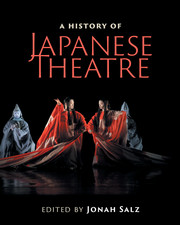Book contents
- Frontmatter
- Contents
- List of figures
- List of tables
- Contributors
- Contributors’ biographies
- Foreword
- Acknowledgments
- Note on Japanese terms
- List of abbreviations
- Timeline
- Editor's introduction
- I Traditional theatres
- Preface to Part I Japanese civilization arises
- II Modern theatres
- Preface to Part II
- 6 Birth of modern theatre: shimpa and shingeki
- Interlude Modern comedies and early musicals
- Interlude Takarazuka: all-girls’ revue and musicals
- 7 Rise of shingeki: Western-style theatre
- Interlude Manzai and Yoshimoto vaudeville comedy
- 8 Wartime colonial and traditional theatre
- Interlude Kami-shibai: picture-card storytelling
- 9 Maturing shingeki theatre
- Interlude Postwar musicals and commercial theatre
- 10 Sixties Theatre
- Interlude Butoh: dance of darkness and light
- 11 Contemporary theatre
- Interlude Tokyo: world theatre capital
- Interlude Charting Tokyo theatre today: 24 November 2012
- Interlude Modern theatre tomorrow: interview with Oriza Hirata
- III Arcs and patterns
- IV Theatre architecture
- Preface to Part IV Evolution of Japanese theatre architecture
- V Theatre criticism
- VI Intercultural influences
- Epilogue: Frozen words and mythology
- Further reading
- Index
- References
Interlude Manzai and Yoshimoto vaudeville comedy
from Preface to Part II
Published online by Cambridge University Press: 05 July 2016
- Frontmatter
- Contents
- List of figures
- List of tables
- Contributors
- Contributors’ biographies
- Foreword
- Acknowledgments
- Note on Japanese terms
- List of abbreviations
- Timeline
- Editor's introduction
- I Traditional theatres
- Preface to Part I Japanese civilization arises
- II Modern theatres
- Preface to Part II
- 6 Birth of modern theatre: shimpa and shingeki
- Interlude Modern comedies and early musicals
- Interlude Takarazuka: all-girls’ revue and musicals
- 7 Rise of shingeki: Western-style theatre
- Interlude Manzai and Yoshimoto vaudeville comedy
- 8 Wartime colonial and traditional theatre
- Interlude Kami-shibai: picture-card storytelling
- 9 Maturing shingeki theatre
- Interlude Postwar musicals and commercial theatre
- 10 Sixties Theatre
- Interlude Butoh: dance of darkness and light
- 11 Contemporary theatre
- Interlude Tokyo: world theatre capital
- Interlude Charting Tokyo theatre today: 24 November 2012
- Interlude Modern theatre tomorrow: interview with Oriza Hirata
- III Arcs and patterns
- IV Theatre architecture
- Preface to Part IV Evolution of Japanese theatre architecture
- V Theatre criticism
- VI Intercultural influences
- Epilogue: Frozen words and mythology
- Further reading
- Index
- References
Summary
Manzai is two-person bantering comedy providing a popular, running satiric commentary on fashions and foibles of modern urban life. Beginning in the Heian period (794–1185), manzai (萬歳 or 万歳) was a magico-religious rite evoking good fortune and long life, performed by a group (for aristocrats) or duo (for commoners) of tayū (lead role) and saizō (subordinate role), who would sing or chant, dance, and play a tsuzumi shoulder drum in celebration of the New Year. In the spirit of the Japanese expression “good fortune comes to a merry gateway,” the performances included humorous and auspicious qualities, grounded in the foolish saizō's dancing and misinterpretation of solemn words, and antagonistic reactions of the tayū. Performed throughout the medieval period by low-ranking, itinerant priest-diviner-entertainers (shomoji) in rural and urban Japan, manzai evolved during the late eighteenth century into an entertainment on the streets and makeshift stages at shrines and temples in urban amusement districts of Kyoto, Osaka, and Edo.
From festive rite to stage art
During the Meiji era (1868–1912), manzai developed into a minor act in the small, affordable yose vaudeville theatres of the burgeoning cities, appealing mainly to commoners. From the late nineteenth century to the late 1920s, it became a protean variety act (iromono) of two to six men and women performing various combinations of comic banter, songs and dances, acting, and physical arts, such as juggling, accompanied by Japanese or Western musical instruments. Manzai entertainers incorporated karukuchi light banter, niwaka improvisations (including parodies) of scenes from more respectable performing arts, and regional ondo singing. In the 1920s, yose suffered as film theatres grew in popularity; however, while rakugo storytelling declined, the ever-adaptable manzai (written as 万才 “many talents” by the mid-1920s) actually grew in popularity.
Yokoyama Entatsu (1896–1971) and Hanabishi Achako (1896–1974) are generally credited as the first to perform purely dialogue-based, stand-up comedy – called shabekuri-manzai – while working under the Yoshimoto Entertainment Company (Yoshimoto Kōgyō; hereafter “Yoshimoto”), a theatre and talent management company established in Osaka in 1912. In an era when most performers and audiences were still wearing kimono, Entatsu sported a Western suit, small mustache, and round spectacles, as he and Achako stood like a couple of pedestrians chatting on an urban street corner. Their style was influenced by Western comic film stars (and former vaudevillians) such as Charlie Chaplin, Harold Lloyd, and Laurel and Hardy.
- Type
- Chapter
- Information
- A History of Japanese Theatre , pp. 248 - 250Publisher: Cambridge University PressPrint publication year: 2016

